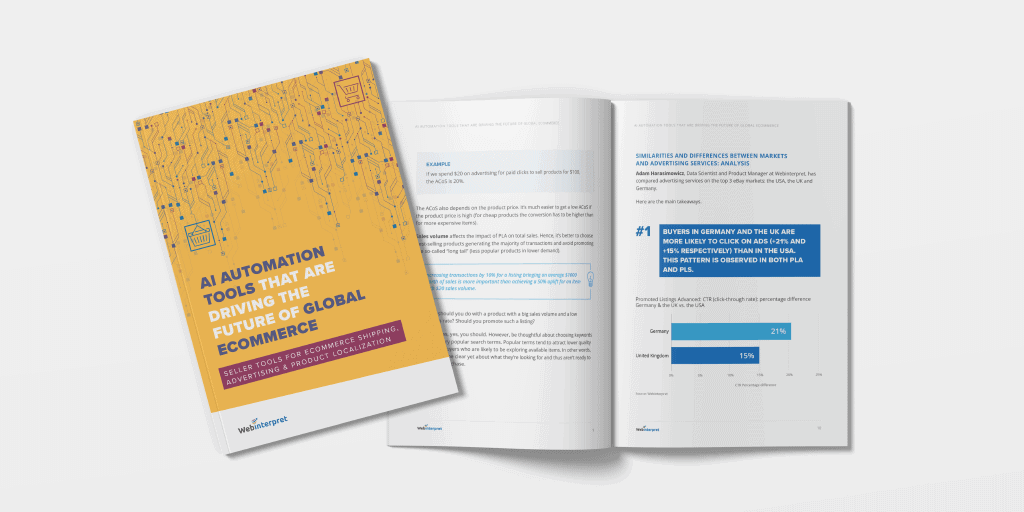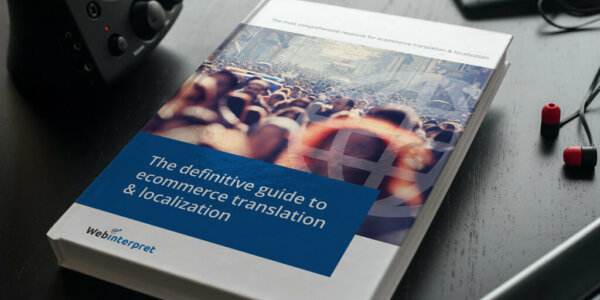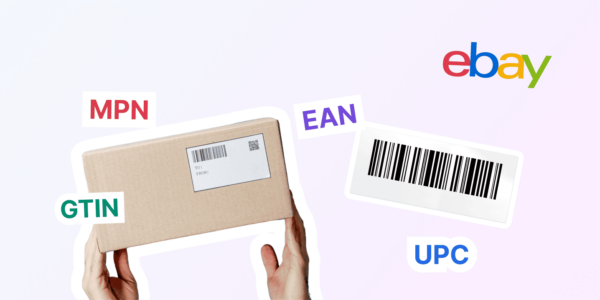Automation: future of global ecommerce [AI seller tool guide]
AI-powered ecommerce automation can help you increase productivity, visibility and, above all, sales.
As your marketplace store grows and you add more listings/products to your inventory, you can expect much more work. This can feel overwhelming, especially if you want to stay one step ahead of your competitors.
This is where ecommerce automation and Artificial Intelligence (AI) come to the rescue.
It’s a game worth playing. For example, automatic optimization of product attributes in listings can increase product visibility by up to 60% and sales by 20%.
Read on and download our comprehensive whitepaper to learn how to use ecommerce automation to grow your sales big time!
In this ecommerce guide you’ll learn about:
- How AI-powered automation can help you achieve optimal results in key ecommerce areas: marketplace advertising, international shipping & returns and product localization.
- An effective ecommerce advertising strategy (with plenty of data and expert advice)
- How to grow your sales with your shipping strategy
- How to offer free and easy international returns to your buyers
- How to localize your product offers on international markets so you can compete on a level playing field with local sellers.
In this no-fluff guide you’ll find plenty of examples, clear instructions and actionable tips based on real data and expert advice.
Ecommerce advertising
In today’s retail market the battle for customer attention is fiercer than ever. The reality is that being first in organic may not mean that much on marketplaces.
As a result, more and more marketplace sellers need ads. Ads positively impact product page views, transactions and revenue. In general, they’re very effective for a short boost in sales. However, a successful long-term advertising strategy is a completely different thing.
Unfortunately, many sellers aren’t familiar with how advertising on specific marketplaces really works.
Ecommerce advertising: challenges and solutions
Did you know that with ad rates recommended by eBay, eBay Promoted Listings can cost you 2-3 times more while not bringing additional revenue?
This example is pretty telling.
The fact is that poor understanding of how advertising and bidding on specific marketplaces work can result in sellers spending more money than necessary. It may not bring the desired ROI, either.
A good understanding of how advertising on specific marketplaces works is essential.
One way of addressing this issue is to use ad agencies. At the same time, it’s not necessary. Automated advertising solutions can help you manage your campaigns in a hassle-free and effective way. As a result, you’ll save time, spend less money and, above all, you’ll make more sales.
For example, AI-based automated campaign optimization can help eBay sellers leverage eBay recommendations, optimize bids and use relevant keywords (with less competition and a higher ROI). Spending on low-performing keywords is significantly reduced and search terms driving sales get more investment.
Ecommerce advertising: our ecommerce guide
In our ecommerce guide you’ll learn about:
- eBay and Amazon Advertising: the essential information and best practices
- How to lower advertising costs and beat competition
- Similarities and differences between markets and advertising services
- What to do when, over time, paid marketing campaigns reach a plateau in a given market, increasing ad spend/CPCs, but not the overall profitability
- How to use automation to achieve the best ROI with your advertising strategy.
Global ecommerce shipping
Is your global shipping strategy efficient? Does it help you grow your sales?
Answering these questions goes beyond offering attractive shipping rates.
In domestic and international ecommerce, fast and reliable shipping solutions are a true driver of sales growth. Efficiency and automating shipping processes are key.
Take ASOS as an example: an ecommerce giant whose worldwide shipping strategy contributed to the company’s global success. Distribution efficiencies and delivery options were on ASOS’ priority list. They enabled the company to ship to many international destinations across the globe within 48 hours.
So, yes, your shipping strategy can help you grow your sales, but it can get tricky if you ship globally.
Global ecommerce shipping: challenges and solutions
Some of the most common detractors to cross-border trade include:
- International shipping costs (too high for many consumers, but also for marketplace sellers)
- International duties and taxes (seemingly too complex).
The reality is that small to medium-sized online sellers rarely have the resources to manage international shipping in the most cost-effective and efficient way. They also tend to lack the experience and knowledge of the shipping industry.
This contrasts with companies that ship high volumes on a daily basis. They’re able to negotiate better rates and discounts, passing on their own lower costs to their clients. Such companies can help small to medium-sized online sellers with their wealth of shipping experience and extensive knowledge of shipping-related matters, e.g. related to duties or taxes.
Furthermore, to ship globally and shorten shipping times, ecommerce sellers can use marketplace fulfillment centers, e.g. Amazon FBA. Having inventory closer to their end customers makes sense if sellers ship a higher volume of fast-moving items to a given location.
One way to deliver goods quickly and efficiently across borders is to use fulfillment centers, e.g. Amazon FBA. Shipping products in-country eliminates the hassle and delays of cross-border commerce.
However, always consider the extra costs and bear in mind that using fulfillment centers may put some extra demands on your business. Therefore, it’s important to diversify your shipping and logistics solutions.
Finally, to minimize your shipping costs, optimize shipping in your ecommerce listings. For this, you need a good understanding of your shipping rates, especially when you sell and ship internationally.
International ecommerce returns: challenges and solutions
An important and challenging aspect of international ecommerce shipping are international returns.
When your sales grow, so does your return rate. Interestingly, high value customers are often the high returning customers.
Now here’s an important fact: your returns processes can make or break your sales.
67% of shoppers review the merchant’s returns policy before purchasing items. If your customers have doubts whether they can return unwanted products in a hassle-free way, this can be the single biggest barrier to ordering from you. Thus, it’s worth reviewing your returns policies and processes.
A flexible and customer-friendly return policy can help you increase your sales conversions by up to 25%.
When it comes to international ecommerce returns, there’s the extra complexity of borders, time zones, foreign exchange rates, currencies and international regulations. On top of this, your returns processes may vary from country to country.
If you have a larger volume of international returns, your administrative costs will rise dramatically. Further, dealing with customs by yourself may be far from straightforward, e.g. you may find retrieving duties/taxes complicated and expensive.
As a consequence, dealing with returns can be both costly and complex for sellers and can negatively affect buyer experience.
Thus, for hassle-free global returns, maximized conversion rates and enhanced customer experience, consider an automatic solution.
Global ecommerce shipping & returns: our ecommerce guide
In our ecommerce guide you’ll learn about:
- International shipping challenges and solutions
- How to handle international returns most efficiently and effectively
- How to automate your shipping and returns processes so they positively affect your business’s bottom line.
Ecommerce product localization
To grow your sales internationally, you need a solid product localization strategy. This goes beyond the mere listing translation.
Ecommerce localization is also about currency and size conversion, communication with foreign buyers, legal restrictions, marketplace SEO or international shipping. But to do all this manually would involve a lot of hassle.
Luckily, today product localization processes can be fully automated. However, it’s not about any automation, but one that takes place in the ecommerce context.
But what does that mean exactly and how can it help you grow your sales on international marketplaces?
Product localization in ecommerce: definition, challenges and solutions
Product localization, common in ecommerce, involves adapting or modifying a product or service for a given language, culture or region. Product localization strategy involves much more than translation.
Ecommerce localization is a term that describes all aspects of preparing your marketplace listings / online store for growing international sales.
The objective is to provide international buyers with an online shopping experience that is indistinguishable from their normal native experience. This way sellers can compete on a level playing field with local competitors.
A fully localized experience involves:
- Ecommerce-optimized translation
- Size conversion
- Currency conversion
- Marketplace SEO
- Keywords used by buyers, browsing for an item
- International payment
- Shipping optimization
- Taking care of restrictions and the legal side.
Furthermore, product localization is:
- Country / culture specific: different countries, different markets. When in Germany, sell as Germans sell: in their local language, currency, using their favorite payment methods, etc.
- Merchant specific: merchants, especially bigger ones, may describe and market their products in their own ways, sell their own brands, use specific brand names, color descriptions, conversion tables or use a special writing style and industry vernacular.
- Platform / channel specific: different ecommerce platforms (eBay, Amazon, Walmart, etc.), different rules. Each platform has its own content structure, text formatting and eligibility rules. Proper category and filter mapping must be ensured.
Now: if you’re wondering whether you can translate and localize your ecommerce listings by yourself, this comes down to a question of capacity and return on investment.
In theory, you can try to translate and localize by yourself. In practice, it can be time-consuming and risky:
- Managing even a modest inventory across multiple markets and channels becomes unsustainable almost immediately.
- Sellers are rarely sure that the end result of their own attempts at ecommerce localization will be of good quality and will bring them orders from abroad.
The video series CEO’s Brew features Adrien Salvat, ecommerce expert and Webinterpret CEO, sharing his insights about the biggest challenges for cross-border selling on marketplaces in 2023. Watch the video below to learn how will the AI revolution impact the marketplace shopping experience:
Product localization: our ecommerce guide
In our ecommerce guide you’ll learn about:
- Successful ecommerce translation and localization
- What’s better for marketplace listings: human or machine translation
- How to make your products easy to find on international markets
- How to optimize keywords and titles to maximize the probability of selling your product
- How ecommerce technology & AI can help you maximize your international sales.
Webinterpret’s AI-powered automated solution for ecommerce
Webinterpret’s AI-based, natural language processing solution will help you optimize your localization processes and costs. It will help you maximize efficiency, ensuring the best return on investment for your marketplace store.
We offer a full product localization package for marketplace sellers: we take care of all translation, price and size conversion, legals, advertising as well as international shipping and international returns. Our solution is perfectly integrated with marketplace platforms, such as eBay or Amazon.
Don’t wait to use automation to grow your sales right now!

Download the complete guide to AI seller tools!
Sources
Related Posts:
Ecommerce Newsletter
By clicking the “Subscribe now” button, you agree to receive our monthly e-mail newsletter and regular marketing and commercial communications by email from Webinterpret regarding marketing trends and our digital marketing services. You confirm that you have read and agreed to Webinterpret’s Terms of Service and Privacy Policy.








